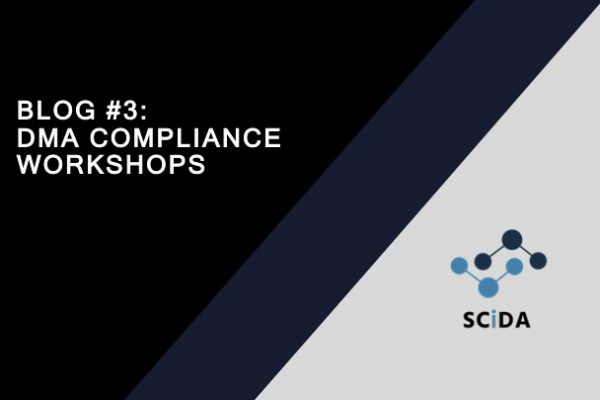Ever since March 8, 2024, a new form of communication has swamped our mobile phones. Friends and family send screenshots with message like this: “I saw this on my phone today. Is this what you talked about with this Digital Mobile Act?“ The pictures show choice screens or consent forms. Okay, to be honest: We were not swamped, and our friends know of course that the M in DMA stands for Monopoly-breaking, not for Mobile. But there were questions, and in this blog post we aim to provide answers as to what changes are actually noticeable for end users? In other words, we ask: what has the DMA ever done for us?
By Jasper van den Boom
The DMA has introduced an elaborate set of rules that mandate changes in many aspects of gatekeepers’ business models. While benefits for consumers are not the be all and end-all, or even the main objective, of the DMA, it certainly intends to change the user experience (preferably for the better). The DMA aims to give users more choice between the gatekeepers’ services and those of competitors, so does this mean that the user experience always gets better? And how have the gatekeepers changed their ways as to comply with the DMA?
For some services, the functionalities and options have increased. For other services, the user may have access to less functionalities, at least if they withhold consent for the cross-use of data between services. Business users may have new options to share links, promotions or offer their products and services. In most instances, they will have to pay additional mark-ups for the use of these functionalities – so consumers are probably unlikely to be swamped with alternative offers any time soon. Business users will also gain new ways or options to access data collected by the gatekeeper upon request, or on the basis of authorization by the user. Advertisers will also gain additional means and options to access information, specifically data related to their performance and pricing. We provide a quick overview hereunder, followed by a more elaborate discussion of the most prominent changes.
| Art. | Alphabet | Apple | Amazon | ByteDance | Meta | Microsoft |
| 5(2) | New consent options, default settings | New consent options, default settings | New consent options | New consent options | New consent options | New consent options, default settings |
| 5(3)(4) (5) | Allow direct promotions in-app | All promotions in-app if authorized | – | – | – | – |
| 5(7)(8) | Allow alternative sign-in for OS | Allow alternative sign-in for OS | – | – | Allow Messenger without FB account | Allow alternative sign-in for OS |
| 6(3) | Allow disabling of Alphabet Apps | Allow disabling of Apple Apps | – | – | – | Allow uninstallation of Microsoft apps |
| 6(4)(6) (7) | Choice screen for browsers & OSEs; Allow third-party payment services in-app | Choice screen for web browsers; Allow third-party app stores & side-loading; Allow third-party payment services; | – | – | – | New options for using third-party services in Search Box & Widgets |
| 6(5) | New buttons and recommendation boxes on horizontal search; more information on results page | Apple allows users to set defaults for its apps | New interface for promotional offers & ranking | – | – | Changes to LinkedIn feed; removed recommendations of Edge |
| 6(9)(10) | API for real-time data transfers | API for real-time data transfers (in fall 2025) | API for real-time data transfers | API for real-time data transfers | Continuous daily data transfers | API for real-time data transfer |
| 7 | – | – | – | – | Allow text-messaging with third-parties from WhatsApp | – |
While the table hereabove provides a direct overview of changes made related to end users, we will discuss briefly what has changed per category of services to highlight the relevance of each change for each gatekeeper.
Operating systems – Path dependency – Whose (de)fault is it anyway?
There are three operating systems to which changes have been made: Android, iOS, and Windows. Users have gained new options to set defaults across all these OS, this includes default apps for opening files, web browsers, search and many others. This seems to be a promising development as it may increase the chance of continued adoption for smaller apps. In Google Chrome, it is easy to navigate to the choice screens for setting a default search engine. Users may also see a pop-up prompting them to change their default when they open a web browser, which facilitates switching as well. However, as seen below, gatekeepers may also use these pop-ups to redirect users back to their own services.

We have learned from experience that end users are quick to fall back into old habits. Any inconvenience caused by the new app can lead to a swift reverting of the default choices. However, ensuring that the gatekeeper give a fair opportunity to competitors is vital to increasing the discoverability of competitors.
Other changes are specific for the OS. Android and Windows are already (relatively) open platforms. Here, downloading third-party app stores or side-loading was already an option.
For Windows, the largest changes include that third-parties are now allowed to offer their services in the search bar and the feed on the Widget Board. The changes in user experience depend on these – often underutilized – use of these services. Users are also allowed to uninstall apps such as Cortana, Edge and the photo gallery.
For Android, users now have a choice screen for their Online Search Engine upon installation, and gain the ability to disable apps, but not uninstall them. As part of its commitments for its web browser, Google Chrome, Alphabet will actually show two choice screens: first to select a default web browser and then for the default search engine. Apple will only show a choice screen for web browsers following the introduction of the DMA, while Microsoft provides more elaborate default settings for web browsers per file type.
The changes to Apple’s iOS are more significant, as Apple maintains a closed and centralized ‘walled garden’ strategy. Apple will allow for the installation of third-party app stores, but these will still have to emerge. These app stores will have to demonstrate that they are financially secure enough to provide aftercare for sales by demonstrating a €1 million line of credit, meet ‘minimum’ safety requirements and assurances that there is no infringement of copyright or illegal materials. This would allow for many interesting evolutions of app marketplaces, in particular in the form of curated app stores, including app stores that represent certain industries (such as media), with a focus on sustainability, or that curate apps specifically for certain demographics such as children. In their workshop, Apple mentioned that one type of third-party marketplace that may arise because they will not be subjected to Apple’s content policies, so they will be able to offer some forms of mature content (in Apple’s view ‘smut’) that are not allowed in the App Store. It will be interesting to see which types of app marketplaces actually arise. The prerequisite being of course that it is affordable to offer these marketplaces and that they are also able to attract the interest of software developers.
App marketplaces – An offer you can’t refuse?
Alphabet and Apple have had to make a number of changes to their app stores. The Commission is, however, not convinced, yet. Here is what’s in it for us when shopping digital content:
Apple users may be in anticipation or wary of the changes to their beloved and trustworthy ecosystems. Will everything get better or worse once Apple no longer holds the reigns over its ecosystem? Irrespective of which side users are on, it will likely take a while before third parties become active on iOS in new and unexpected ways. This has to do with Apple’s changes to its business terms.
According to Apple’s new policy, developers will be able to choose between the new business terms or the standard business terms. The standard business terms follow the old model, full intermediation by Apple. The new business terms allow developers to offer their apps outside of the App Store, or use third-party payment systems. They must pay a number of fees. For any download on an Apple device under the new business terms (whether inside or outside of the App Store), developers will have to pay €0,50 (the so-called Core Technology Fee, or CTF) per first annual download, at least after the 1st million downloads. If the purchase is made through the App Store, the developer will pay either 10 or 17% depending on which terms apply (down from 15 or 30% under the standard terms). Developers will also be charged 3% for using Apple’s in-app payment system under the new terms. As a result, offering free apps or apps with very low prices is likely more attractive under Apple’s standard terms, limiting the types of apps for which using third-party app stores is attractive. For any app under €1,50, the CTF alone would be higher than Apple’s maximum intermediation costs, notwithstanding any additional prices paid by the developer.
Consequently, it is likely that users will mostly find new and interesting apps if they are not allowed on the Apple App store, and not blocked on the basis of Apple’s Notarization process (excluding copycat and cracked apps or apps that infringe on copyright). In other words, early third-party app stores are likely to relate to niche interests, or game marketplaces that sell their games at full prices (if Apple does not ban them from iOS again). Or, as some renowned economists put it: “The tariff announced by Apple in fact achieves the exact opposite of the DMA objectives by making entry of rival stores commercially unviable due to their inability to attract popular apps.”
Alphabet has made marginal changes to its policies, and has already indicated not much will change for users: third-party app stores were already allowed (and barely used), but it will not allow for direct links to websites and third-party payment services by app developers in-app. In short, users may get more links to click in their apps, with varying results. However, if users purchase a service or subscription through these links, the app developer will have to pay intermediation fees (5% for renewable subscriptions and 10% for other digital goods, this applies for the first two years after the first purchase) and maintenance fees (17%) to receive updates and protection. There are also fees for user billing ranging between 3 and 4%. It looks like again, in many instances, these fees will end up higher than just using Alphabet’s Play Store (ranging from 15-30%). The main difference is that Alphabet does not charge any upfront fees similar to Apple’s CTF, which means that developers do not pay a standard fee for free apps. The outcome is however the same, a lot of downside for limited upside. Who would pay extra just for the ‘scare screens’ that push users back to the gatekeeper’s app stores and ecosystem?

Image from the CMA Market Study into Mobile Ecosystems
Thus, while users technically have more choice in and outside of the App & Play Store, the impact of these changes is likely limited. At least for now.
Data collection and portability – Is consent free when dissent comes at a price?
All gatekeepers have introduced new or updated consent screens in relation to Article 5(2) DMA. Here, users have to give permission for the cross-use and combination of personal data across services. As a result, users will not be given personalized recommendations based on data collected from Google Search for YouTube, or collected from the Amazon Marketplace for video recommendations on Prime. In some instances, withholding consent for the cross-use of data will disable functionalities, for instance related to cross-posting content across Instagram and Facebook or directly importing location results from Google Chrome into Maps.
So what is the actual impact for users? On the one hand, it seems that most services will mostly remove functionalities if consent is withheld, so there is not a direct benefit for users in doing so. Google Maps no longer shows up directly in search when you look up a restaurant if you have not given consent. This is the price of freedom. It does give users more control over how their data is used across platforms and for personalized advertising.
At least to the extent that gatekeepers facilitate this: ByteDance and Meta have interesting work-arounds that are likely to be tested in court.
- ByteDance argues that its video-sharing service TikTok and its advertising service are part of the same platform. Therefore, data sharing consent is not necessary as data is used within the same core platform service.
- Meta will only stop combining data for the purpose of advertising if users subscribe to their paid social media program. This is the alternative offered. Some of the collected data (for instance through iOS or Windows) had already not been used for advertising.

This means in practice that many users will only see the downsides to withholding consent for the cross-use of data, while only tech-savvy, privacy super-conscious, or other geeks and freaks will think of the benefits of withholding consent. If the reception of cookie banners is any indication, we may have to make sure that everyone understand why they click agree or decline on a more fundamental level than the explanation provided by Big Tech. At least, Margrethe Vestager told the Internal Market Committee of the European Parliament on 3 April 2024 she never accepts cookies.

Users will also gain more control over their data as they can directly port it to third-parties. Here again, gatekeepers offer different solutions:
- Microsoft, Alphabet and ByteDance offer an API to third-parties that allows them to import the data with authorization of the user.
- Meta allows a daily data transfer with user authorization.
- Apple is still working on its data access API, expected to be delivered in fall 2025 (in a strange understanding of the timeline of DMA compliance).
This impacts how users can make use of their rights under 6(9) DMA. Some gatekeepers will allow data to be ported with the click of a button on the third-party website, while other gatekeepers require the user to submit a request for data portability. While this reduces switching costs for users and allows them to take their data, gatekeepers rightfully noted that data portability also creates risks. For instance, not every user would want to port their full internet search history (especially some users that are active on the third-party app stores Apple has warned us for…).
Search results and recommendations – Now you see me, now you don’t?
The benefits for users in terms of search results – generally implemented for the purpose of complying with 6(5) DMA – are quite limited. Alphabet’s compliance mechanisms allow for more metadata to be included in the search results page, meaning we will see more prices, pictures and reviews on the main page. It has also included new buttons that lead to third-party search services rather than its own. Amazon has reviewed its ranking algorithm, and LinkedIn allows you to see more or less personalized recommendations across different services. The question as to how users experience these changes – and if they even notice them – are dubious. This was also demonstrated through the comparison hereunder, taken from the presentation of the Heureka group before the Committee on Internal Market and Consumer Protection, where Thomas Braverman voiced the views of Heureka and other European comparison shopping services that Alphabet simply was not doing enough to comply.

Messaging – One app to text them all?
Changes to messaging services will perhaps be most notable for users, at least after they are implemented, the implementation is a multi-year plan, starting with only text-based communications in year 1. Meta has allowed third-party messaging services to request connecting to WhatsApp, allowing users to send messages (for now only text-based) to users on other platforms. Users can also download a stand-alone version of Messenger, allowing you to communicate through Meta’s ecosystem without a Facebook profile. As network externalities are strong in messaging services, this may actually help new messaging services to gain a foothold. Maybe those who are wandering the deserted plains of Signal will finally have a means to reconnect with the rest of society (at least if they have any desire to), time will tell. When interoperability does arrive, Meta promises that it will look something like this.

Mission accomplished?
The first changes for users since March 7th are visible. They involve new choice and consent moments and mechanisms, improved information and settings flows, enhanced data control, more control to use third-party apps and services, graphic changes and more. These changes are just for end users, while business users and advertisers enjoy benefits and new possibilities under the DMA that are not discussed here. As noted by Thierry Breton, we have already seen more changes [red. in the “right” direction] in the gatekeeper’s behaviour since March 7th than in the 10 years before.
While these are steps in the right direction, this blog has also highlighted how reluctance of gatekeepers to open themselves up to competition still limits which options users have access to, and potentially how much will change in the future. Whether users can use new app stores, get better deals, or gain better control of their data, depends on how well compliance mechanisms are implemented. As many already know, the Commission is keeping a watchful eye, and is not afraid to investigate if it believes the changes are not compliant. Meanwhile, we hope that our friends and family will keep contacting us about this new Digital Mobile… Monopoly-breaking… Markets Act. After all, gatekeepers have made it clear in the compliance workshops that their obligations end with providing the choice for users, and that it is not their responsibility which choices users actually make. So we hope that end users keep informing themselves, be it through their knowledgeable social circles, by following the Commission’s and gatekeepers’ activities, or by reading some very helpful blogs that provide such overviews.




